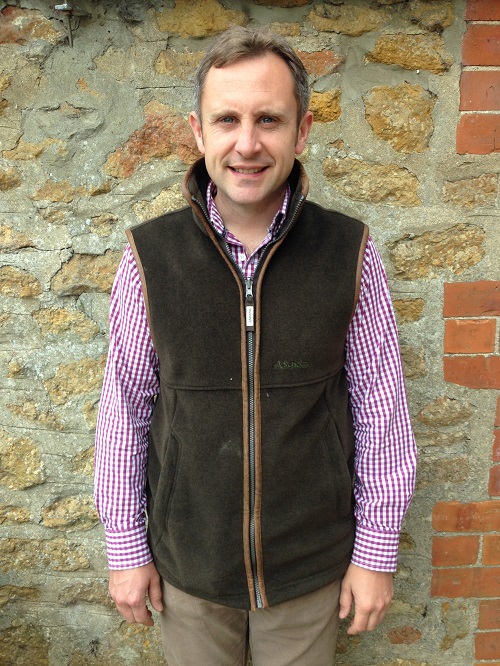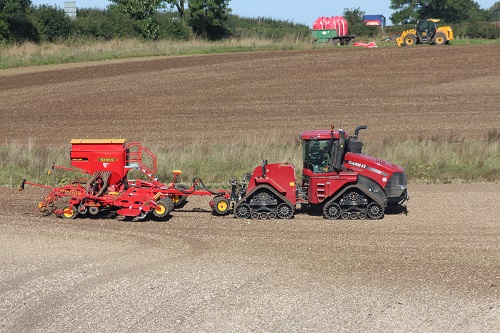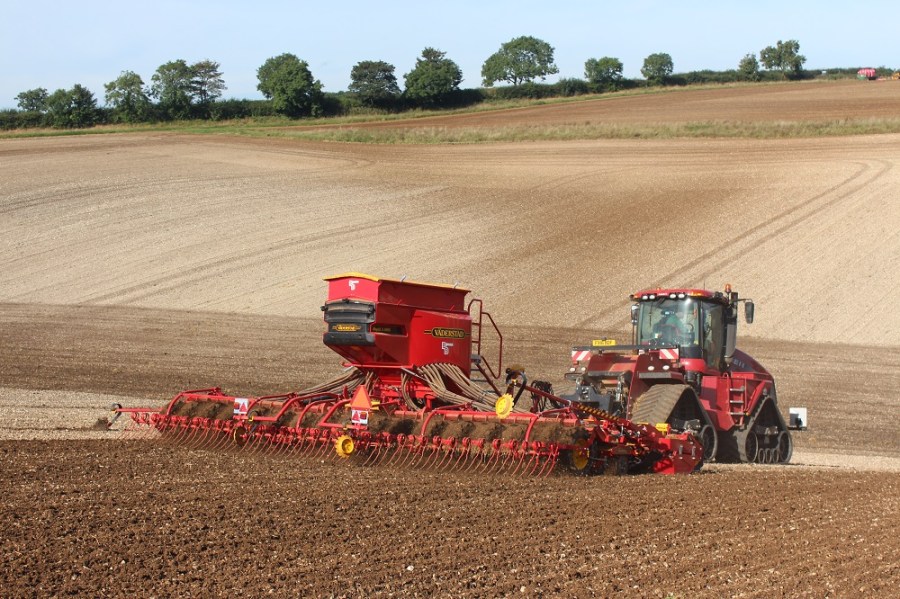The relaunch of the Väderstad Rapid RDA800S boasts significant changes to aid farm efficiency and crop establishment. CPM visits one large farming estate whose autumn drilling campaign has been aided by the latest developments.
It’s so versatile, whatever the weather we can always get the job done.
By Matthew Sharp
Driving down production costs while maintaining crop output and quality has been a key focus for Sir Richard Sutton Limited. Led by its head of farming Chris Baylis, this has taken something of a change in direction in recent years.
“Our long-term objective is to move to direct drilling or conservation tillage,” he says. “However, with our current system, we’ve managed to drive down costs and it’s performing well. It’s so versatile, whatever the weather we can always get the job done.”

Chris Baylis’ long-term objective is to move to direct drilling or conservation tillage.
There’s a total of 6000ha of cropping across the two principle estates in Berks and Lincs. The mainly arable Lincs operation comprises 3600ha from as far north as the River Humber back to its base at Hall Farm, Stainton Le Vale, with land primarily in four blocks.
When Chris Baylis joined the company in 2011 as farm business estate manager for the Lincs estate, his remit was to improve operational efficiency by reducing production costs and improving the farm’s overall performance. “It’s not something that’s easy to do because it’s a large business that’s already well managed,” he notes.
“But when I arrived, the company was considering direct drilling as a means of achieving this while improving soil health.”
The plan was to convert the system gradually over four years, increasing the area direct drilled by 25% each year. “Our first year in 2011 was excellent and we direct drilled about a quarter of the area in Lincs,” he recalls.
“But a further analysis of the figures showed such a rapid conversion to direct drilling may not be such a good idea. I worked out that if direct drilling had more than a 3% impact on yield then it was worth staying with what we were doing.

The improvements Väderstad has made to its drill include better access to the gangway and seed hopper, which means filling up is easier and safer.
“So we decided to convert just 40% in total, to justify the purchase of the drill, and evaluate the system over a complete rotation of six years. The rest of the estate would stick with the conventional min-till system.”
But autumn 2012 proved to be “an absolute disaster”, and the direct-drilling system failed. “The soil conditions weren’t suitable and the drill coulter created awful slots which didn’t close properly, especially on the heavier land. Our soils weren’t ready for direct drilling, nor was the drill we were using suitable for our land.”
Chris Baylis looked for other options of establishment which wouldn’t compromise crop quality but would keep his costs under control. As a result, he and farm manager Malcolm Vaughan decided to sell the direct drill in 2013 and opted for a Väderstad Rapid 800S, complete with a Cultivating Solutions RapidLift toolbar, bought through Lincs-based B&B Tractors.
“We decided on buying a Väderstad Rapid mainly because it could do what we required and was versatile enough to cope with our varying soil types. Whether we were drilling into ploughed land or direct into stubbles, the Rapid could do it with some simple adjustment of the legs, discs and coulters on the RapidLift.”
The oilseed rape is established in one pass, with the RapidLift toolbar engaged to help create a tilth in front of the 410mm diameter disc coulters. “For wheat after OSR, we put the Great Plains SL700 through first, with low-disturbance legs, and then follow this with the Rapid.”
After wheat, if the land is going into a spring crop, it gets an autumn pass with the SL700, then half of the land is drilled with a cover crop. This is grazed and then sprayed off in the spring, with the toolbar lifted out the way on the Rapid, so it effectively behaves as a direct drill.
“We’re finding our way with cover crops,” notes Chris Baylis. “I’m not convinced of their value where we have bad blackgrass as I suspect they suppress it and the blackgrass comes through in the spring.”
The spring crop is followed by winter barley, with an 8f Lemken plough turning the soil in front of the Rapid. “I’m really pleased with this system – the beauty of the Väderstad drill is its versatility – you can strip till for OSR, or use it as a conventional cultivator drill on ploughed or min-tilled soil. It’s helping us through this transitional phase as we head towards true conservation tillage.”
Chris Baylis was so impressed by the machine he bought a second one in July this year. This also tied in efficiencies in his cropping plan.
“We were drilling land between the Humber and back at Stainton Le Vale and had to go between the two. We made the decision to block crop the land into 120ha units with the aim of reducing management and machinery costs.”
Each block could be harvested in one day with the estate’s two high output combines and covered with the sprayer in just half a day. “The purchase of a second drill allowed us to establish the crop in one day too. It’s reduced our downtime and means we spend less time travelling from field to field, creating further efficiencies.”
This change also means the business can adapt the cultivations better to the soil type across the Lincs estate. “The medium loam chalky Wold land has controllable blackgrass and can be drilled early. The ideal drilling window for wheat on our heavy clay soils where blackgrass is more of a problem is the end of Oct to early Nov.”
The introduction of the second Rapid has also freed time and labour capacity up in the spring so a greater area of spring cereals can be drilled. This further enhances the campaign against blackgrass.
Although there’s only three years between them, Chris Baylis is impressed with the new features introduced on the Väderstad Rapid RDA800s.
“The new drill really is a pleasure to use. We can control it through an iPad, which has a very user friendly layout, and works over Wi-Fi. That means there are no cables and you can switch it easily between tractors.”
There’s praise too for the front packer roller on the new drill. “It’s new to us, although has always been available as an option, I believe. You get better consolidation of the seedbed and more even seed depth. You can see the improved seedbed where we have operated the drills side by side. We’re now thinking of adding the front packer to our older model.”
The newer drill is also fitted with Väderstad’s SystemDisc Aggressive front toolbar. Introduced in 2013 and taken from Väderstad’s Carrier, SystemDisc comprises two sets of 410mm diameter conical-shaped discs that intensively prepare the soil in front of the coulters. SystemDisc Aggressive boasts bigger discs and stronger bearings, which Väderstad claims ensures soil clods and crop trash are displaced, creating a finer and more uniform seedbed.
“Used after the SL700, you get better incorporation and mixing of the previous crop residue. It’s improved the evenness of establishment and reduced slug pressure,” says Chris Baylis.
Brand new on the Väderstad Rapid is ‘SeedEye’ technology which means drill calibration is easier, more reliable and less hassle for operator Justin Kirkwood.
As seed flows down the drill’s hoses and past its sensors, which are lit with infrared light, each seed creates a break in the light allowing the sensors to pick this up. The number of breaks are collected and processed by the SeedEye allowing seed volume to be determined. The system claims to have 99% accuracy on rapeseed and 98% accuracy on cereal grains, counting 250 seeds per second.
“Justin can set the seed rate from the control panel which reduces the time and effort required when changing seed or crop. He has full control through the iPad display and if there are any blocked coulters or problems, the system just sounds an alarm in the cab.
“It’s designed to be far more accurate and we’re working on a seed rate per m2 basis, rather than kg/ha, allowing us to be far more precise. It also means we won’t need to base our decisions on thousand grain weight.”
However, the system hasn’t been working properly, with the result that they’ve been unable to use SeedEye for the drill’s first autumn. “We’ve also had problems with the blockage sensors,” notes Chris Baylis.
“But we’ve had fantastic back-up and support from Väderstad. The SeedEye glitch should be rectified by a software update, and we’re confident it should be working properly in the spring.
“I’ve used various Väderstad machines over the years and they’re really well built. Their residual value is also good – second-hand machines sell well and at strong prices.”
The improvements Väderstad has made to its drill include easier access to the gangway and seed hopper. “This means filling up is far easier and safer, and setting up is quicker, especially when changing between crops.” A new integrated lighting system on the redesigned hopper ensures better visibility on those long nights sowing.
Väderstad has also changed its fan which is now hopper-mounted and fully integrated. The unit, which runs at a lower speed, reduces fuel consumption and is far quieter but there’s no adverse impact on performance, says the company. The fan increases drilling accuracy due to the reduction in dust and plant residue getting in, it adds.
Aside from the physical changes Väderstad has made to their drill, both Rapid drills have a firm place at Hall Farm due to the significant cost savings they’ve brought to the estate, says Chris Baylis.
“We were using 66 l/ha of fuel for establishment previously. Now we only use 18 l/ha for direct drilling while our average usage for establishment across the estate is 22 l/ha. This has drastically reduced establishment costs.
“Add to this to the fact we’ve completely eliminated the need to use our press – previously we used a Rexus press ahead of the drill on heavier land for the establishing barley. So all-in-all, we’ve reduced our establishment costs quite significantly.”
Farm Facts
Sir Richard Sutton Limited, Hall Farm, Lincs
- Farmed area: 3600ha in Lincs
- Soil type: medium loam chalk on Wolds and heavy clay
- Staff: Four full time plus Malcolm Vaughan
- Rotation: Winter barley, oilseed rape, winter wheat, spring wheat, spring beans
- Mainline tractors: 2x Case Quadtrac, Challenger 765, 3x Massey Ferguson 7720
- Combines: 2x Claas Lexion 780
- Drills: 2x Väderstad Rapid RDA 800S
- Sprayers: Dammann DT2500 with 5000-litre tank; Bateman RB35 with 4000-litre tank; both with 32m boom




